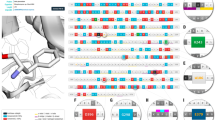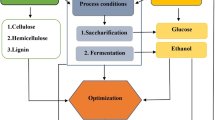Abstract
The Michaelis-Menten constant Km is a very important parameter to relate enzyme with its substrate in enzymatic reaction. Although Km can be experimentally determined, the Km values are not easily available in literature. With rapid increase of newly designed enzymes, we face the shortage of parameters related to enzymatic reactions. The beta-glucosidase is a crucial enzyme for cellulose hydrolysis and cellobiose is one of its substrates. In this study, we attempt to develop models to predict Km with cellobiose as substrates using information about primary structure of beta-glucosidase. The results show that the 20-1 feedforward backpropagation neural network using the amino-acid distribution probability as predictor works best for prediction of Km values.
Similar content being viewed by others
References
Berrin, J.G., Czjzek, M., Kroon, P.A., McLauchlan, W.R., Puigserver, A., Williamson, G., Juge, N. 2003. Substrate (aglycone) specificity of human cytosolic beta-glucosidase. Biochem J 373, 41–48.
Burlingame, A.L., Carr, S.A. 1996. Mass Spectrometry in the Biological Sciences. Humana Press, Totowa.
Cai, Y., He, J., Li, X., Feng, K., Lu, L., Feng, K., Kong, X., Lu, W. 2010. Predicting protein subcellular locations with feature selection and analysis. Protein Pept Lett 17, 464–472.
Chou, P.Y., Fasman, G.D. 1978. Prediction of secondary structure of proteins from amino acid sequence. Adv Enzymol Relat Subj Biochem 47, 45–148.
Cooper, G.M. 2004. The cell: A Molecular Approach. ASM Press, Washington DC.
Darby, N.J., Creighton, T.E. 1993. Dissecting the disulphide-coupled folding pathway of bovine pancreatic trypsin inhibitor. Forming the first disulphide bonds in analogues of the reduced protein. J Mol Biol 232, 873–896.
Demuth, H., Beale, M. 2001. Neural network toolbox for use with MatLab. User’s guide, Version 4.
Desriani, F.S., Sode, K. 2010. Functional expression of Phanerochaete chrysosporium cellobiose dehydrogenase flavin domain in Escherichia coli. Biotechnol Lett 32, 855–859.
Dill, K.A. 1985. Theory for the folding and stability of globular proteins. Biochemistry 24, 1501–1509.
Dwyer, D.S. 2005. Electronic properties of amino acid side chains: Quantum mechanics calculation of substituent effects. BMC Chem Biol 5, 2.
Feller, W. 1968. An Introduction to Probability Theory and Its Applications. 3rd Edition, Vol. I. Wiley, New York.
Jeng, W.Y., Wang, N.C., Lin, M.H., Lin, C.T., Liaw, Y.C., Chang, W.J., Liu, C.I., Liang, P.H., Wang, A.H.J. 2011. Structural and functional analysis of three beta-glucosidases from bacterium Clostridium cellulovorans, fungus Trichoderma reesei and termite Neotermes koshunensis. J Struc Biol 173, 46–56.
Kawashima, S., Pokarowski, P., Pokarowska, M., Kolinski, A., Katayama, T., Kanehisa, M. 2008. AAindex: Amino acid index database, progress report 2008. Nucleic Acids Res 36, D202–D205.
Kyte, J., Doolittle, R.F. 1982. A simple method for displaying the hydropathic character of a protein. J Mol Biol 157, 105–132.
MathWorks Inc. 1984–2001. MatLab — The Language of Technical Computing (version 6.1.0.450, release 12.1).
Scheer, M., Grote, A., Chang, A., Schomburg, I., Munaretto, C., Rother, M., Söhngen, C., Stelzer, M., Thiele, J., Schomburg, D. 2011. BRENDA, the enzyme information system in 2011. Nucleic Acids Res 39(Database issue), D670–D676.
Shen, J., Agblevor, F.A. 2011. Ethanol production of semi-simultaneous saccharification and fermentation from mixture of cotton gin waste and recycled paper sludge. Bioprocess Biosyst Eng 34, 33–43.
The UniProt Consortium. 2010. The Universal Protein Resource (UniProt) in 2010. Nucleic Acids Res 38, D142–D148.
Trinquier, G., Sanejouand, Y.H., Hausman, R.E. 1998. Which effective property of amino acids is best preserved by the genetic code? Protein Eng 11, 153–169.
Tsukada, T., Igarashi, K., Fushinobu, S., Samejima, M. 2008. Role of subsite +1 residues in pH dependence and catalytic activity of the glycoside hydrolase family 1 beta-glucosidase BGL1A from the basidiomycete Phanerochaete chrysosporium. Biotechnol Bioeng 15, 1295–1302.
Wu, G., Yan, S. 2006. Mutation trend of hemagglutinin of influenza A virus: A review from computational mutation viewpoint. Acta Pharmacol Sin 27, 513–526.
Wu, G., Yan, S. 2008. Lecture Notes on Computational Mutation. Nova Science Publishers, New York.
Wu, G, Yan, S.M. 2002. Randomness in the primary structure of protein: Methods and implications. Mol Biol Today 3, 55–69.
Yan, S, Wu, G. 2010. Creation and application of computational mutation. J Guangxi Acad Sci 17, 145–150.
Zamyatin, A.A. 1972. Protein volume in solution. Prog Biophys Mol Biol 24, 107–123.
Author information
Authors and Affiliations
Corresponding author
Rights and permissions
About this article
Cite this article
Yan, SM., Shi, DQ., Nong, H. et al. Predicting Km values of beta-glucosidases using cellobiose as substrate. Interdiscip Sci Comput Life Sci 4, 46–53 (2012). https://doi.org/10.1007/s12539-012-0115-z
Received:
Revised:
Accepted:
Published:
Issue Date:
DOI: https://doi.org/10.1007/s12539-012-0115-z




